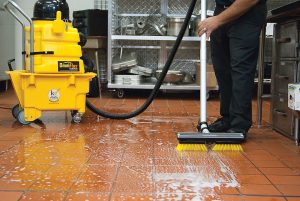— By Marc Ferguson —
A closer look at electrostatic sprayers.
Of all industries, COVID-19 has impacted the hospitality industry just about the hardest. Now, as restaurants around the country begin to reopen, most are taking several steps to ensure patrons feel safe and are safe in their properties.

Marc Ferguson, Kaivac
One restaurant in Texas went so far as to hire a “bathroom monitor.” The duties of this bathroom monitor is to clean restrooms after every use.
While most restaurants and hospitality properties are increasing cleaning frequencies considerably, for most, cleaning restrooms after every use is not in the cards. Instead, along with more cleaning and disinfecting, they are ensuring workers know how to use these cleaning solutions properly.
Further, some are selecting electrostatic sprayers. Independent studies have indicated that these machines can prove effective. However, recently, the Centers for Disease Control and Prevention (CDC), the World Health Organization (WHO) and the U.S. Environmental Protection Agency (EPA) have expressed concerns about electrostatic sprayers.
To better understand these apprehensions, we need to know a bit more about electrostatic sprayers. These machines are not new. They were first introduced in the 1930s but were confined to specific industries such as painting and coating.
 Essentially, they apply a disinfectant over a wide area. The liquid is given an electrical charge so that it attaches to surfaces as it is used. Once on those surfaces, the disinfectant goes to work, killing germs, pathogens and infectious viruses…or, at least, that is the goal.
Essentially, they apply a disinfectant over a wide area. The liquid is given an electrical charge so that it attaches to surfaces as it is used. Once on those surfaces, the disinfectant goes to work, killing germs, pathogens and infectious viruses…or, at least, that is the goal.
This sounds like the right system at the right time. So why the reservations? Here are four concerns restaurant owners and managers should be aware of:
1. They Don’t Clean
Let’s be clear about one thing: electrostatic sprayers are not designed to clean surfaces. They just apply a disinfectant to surfaces. This is not always clear when first considering electrostatic sprayers.
2. Breaches Cleaning Best Practices
Disinfectants are complicated. Each manufacturer will have different instructions on how to use the disinfectant. However, most all share one thing in common: the surface must be cleaned first and then disinfected. This is a cleaning best practice.
But, it is not always practiced when using electrostatic sprayers.
WHO says that when using electrostatic sprayers, “the disinfectant is inactivated by dirt and debris.” This means we may spray surfaces with an electrostatic sprayer, believing we have killed COVID germs, when we have not.
3. Dwell Time Concerns
Disinfectants must dwell on surfaces for a few minutes before being wiped clean. Here is something else we need to know. When a disinfectant “sets” on a surface, it must remain wet. Further, when using electrostatic sprayers, this dwell time may be extended. So, let’s assume a surface has been sprayed with an electrostatic sprayer. The disinfectant is supposed to dwell on that surface for ten minutes to ensure all pathogens are killed. However, it dries after six minutes. Are the germs that cause COVID killed by this disinfectant in six minutes? The manufacturer would likely not stand behind the product in such a situation, nor should restaurant owners and managers.
4. Not Adhering to EPA Guidelines
Currently, the EPA is questioning the use of electrostatic sprayers because disinfectants are not used the way the EPA tested them. Let’s explain. The EPA tested the disinfectant by applying it to a surface, allowing proper dwell time and then wiping the surface clean, following the use instructions of the manufacturer. The surface is then tested to ensure the pathogens on that surface are killed, and if so, the disinfectant is EPA-certified. But this disinfectant was never tested using an electrostatic sprayer. As a result, the EPA says:
“Applying a product in a way that does not align with its intended use may render the product less effective.”
Options
Our goal here is not to say electrostatic sprayers should not be used. Our goal is just to point out some issues restaurant owners and managers should know.
When it comes to cleaning and protecting health, what might prove most effective for restaurant owners and managers is to clean all surfaces using a spray-and-vac or dispense-and-vac cleaning systems. Use electrostatic sprayers only as a backup, or when there are specific concerns about COVID in the property.
With spray-and-vac systems, a cleaner/disinfectant is applied to all surfaces. The solution cleans surfaces and disinfects, all in one step. The same areas are then power rinsed with fresh water. From this single, multi-purpose platform, all moisture, soils and pathogens are then vacuumed up, a process that is recommended. Independent tests have proven this cleaning method is highly effective at removing health-risking pathogens from surfaces.
With COVID, the restaurant industry must know as much as possible about how to stop the spread of this disease. They must know what works, what does not work, and what may not be needed. Due diligence is highly recommended. There is no time for “trial and error” cleaning when it comes to COVID-19.
— Marc Ferguson is the vice president of global sales for Kaivac, developers of the No-Touch Cleaning® system and the OmniFlex™ Crossover Cleaning system. He can be reached via his company website, www.kaivac.com or by email at [email protected].
